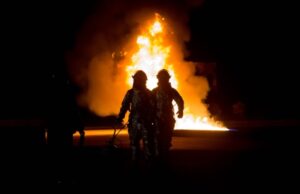
U.S. Marines with Aircraft Rescue and Firefighting (ARFF), ignite fuel before the start of a controlled burn exercise at Marine Corps Air Station in, Cherry Point, NC, in December 2017. The DoD stopped the use of per- and polyfluoroalkyl substances, which have been linked to kidney cancer in military personnel, for training in 2020 by order of Congress. U.S. Marine Corps photo by Sgt. Colin Broadstone
DURHAM, NC — Kidney cases continue to rise nationwide, with more than 81,600 individuals expected to be diagnosed with the disease by year-end, the American Cancer Society estimates. That builds on a trend started in the 1990s that has seen incidence rates rise an average of 2% per year. Worldwide, the incidence of renal cell carcinoma, the most common type of kidney cancer, has doubled since the 1970s.
While much of the increase in diagnosis is attributed to expanded use of imaging, which enables incidental findings of small tumors, researchers note that increased rates of obesity, diabetes and hypertension—all known risk factors for the malignancy—may play a role in the steady rise of kidney cancers, as well.
Some environmental exposures also elevate the risk of RCC, particularly for veterans. “Active-duty service members are at increased risk of exposure to chlorinated solvents, petrochemicals, and heavy metals, all of which have been associated with increased risk of RCC,” according to the Congressionally Directed Medical Research Programs’ Kidney Cancer site.
In addition, the VA notes that the Agency for Toxic Substances and Disease Registry says some studies in humans suggest that certain perfluoroalkyl and polyfluoroalkyl substances (PFAS), which the DoD began using in the 1970s to fight fuel fires, may also be associated with kidney cancer. This use “is a major source of PFAS contamination of groundwater on military bases,” the VA said.
Older age and smoking also increase the risk of kidney cancers.
As a group, veterans have higher rates of all these risk factors. Further, males have nearly twice the risk of RCC compared to women. Overall, male veterans face a five- to six-fold increased risk of renal cell carcinoma (RCC) compared to males who have not served in the military, making research and awareness of treatment options of significant importance to health care providers in the VA and DoD.
Fortunately, there is a presumed service connection for veterans who developed any type of kidney cancer and were exposed to contaminants in North Carolina’s Camp Lejeune water supply between August 1953 and December 1987. In addition, the PACT Act signed into law in August 2022 recognized kidney cancer, including renal cell carcinomas of all types, as presumptively related to service in the Gulf War and post-9/11 veterans.
“The PACT Act is transformational for veterans who may need cancer care,” said Michael Kelley, VHA national executive program director for oncology. “Thanks to this legislation, we can provide them with best-in-class cancer care.”
Understanding RCC
Renal cell carcinoma represents 90% to 95% of all kidney cancers. The classic triad of symptoms includes blood in the urine, flank pain and palpable masses, but only 10% of patients with RCC have these symptoms at diagnosis. While the majority of cases are asymptomatic, patients may present with nonspecific symptoms such as fever, weight loss, fatigue and a high white blood cell count.
With relatively few patients experiencing symptoms clearly associated with kidney cancer, the same incidental findings on imaging that have increased the number of RCC diagnoses can be lifesaving for patients. The 5-year survival rate for kidney cancer overall is 77%, but lumping the survival rates of patients diagnosed at all stages together obscures the dramatic differences in outcomes based on the spread of the disease at presentation.
For those with cancer contained entirely in the kidney, Stage I (up to 7 cm in size) and II (larger than 7 cm), the 5-year relative survival rate is 93%. Once the malignancy has reached Stage III by spreading to the surrounding fatty tissue, the vena cava or renal vein, the urine-collecting structures of the kidney or nearby lymph nodes, the 5-year relative survival rate drops to 72%. If the cancer is first detected after the main tumor has grown beyond the kidney, called advanced RCC, or the cancer is present in distant lymph nodes or other organs, metastatic RCC, the 5-year relative survival rate is just 15%. Both advanced and metastatic RCC are Stage IV cancers.
Treating RCC
Treatment of primary local or regional RCC can include surgery, ablation or arterial embolization to remove, destroy or starve the tumor of the blood supply it needs to grow and spread. For certain low-risk, small tumors, active surveillance may be the initial approach.
A recent review of advances in the management of renal cell carcinoma said that “for stages I to III RCC, partial or radical nephrectomy is the preferred treatment for patients who are surgical candidates.”1 When possible, partial nephrectomy is considered the best option, as it reduces the risk of long-term renal dysfunction by preserving nephrons, the researchers noted.
Radiation therapy or chemotherapy also may be used to attack the tumor and reduce the likelihood of a recurrence, but immunotherapy has shown benefit for patients with higher risk of disease recurrence, including those with pT4 tumors, lymph node involvement, high-grade tumors and sarcomatoid features.
Despite successful surgery and adjuvant therapy, up to 50% of patients with RCC experience a recurrence, and one-third of patients have metastatic disease at diagnosis. Patients with recurrent or Stage IV RCC may have surgery to reduce or eliminate the tumor(s), if possible, or they may receive systemic therapy. The preferred treatment for clear cell RCC with poor risk features is systemic therapy.
- Cardenas LM, Sigurdson S, Wallis CJD, Lalani AK, Swaminath A. Advances in the management of renal cell carcinoma. CMAJ. 2024 Feb 25;196(7):E235-E240.

